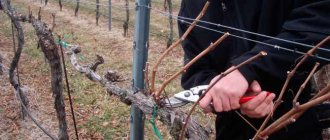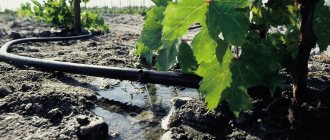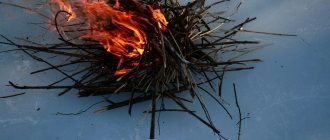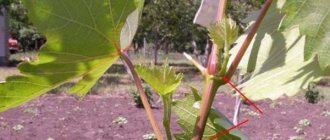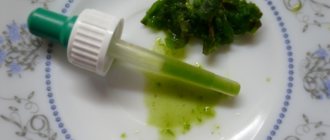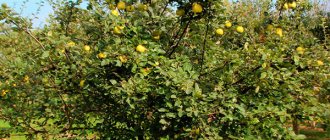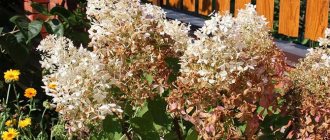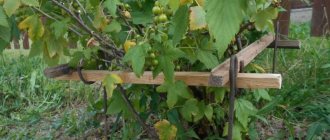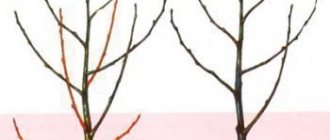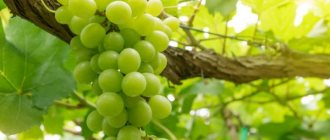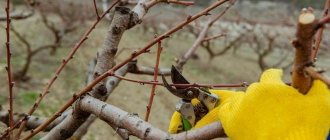How to rejuvenate an abandoned bush?
1. First, inspect the bush and identify the strong young branches of this year; they should be left for the next season for fruiting. Then for each such vine we will leave a replacement knot. 2. Identifying weak sleeves. These are those that do not have mature, strong vines. A vine with a thickness of 7 mm or more, and also with 7 or more eyes, is a normal vine. Vines that are more than 10 mm thick and have more than 10 buds are considered strong. The remaining vines are considered weak. We remove all small, diseased, old branches around them. After removal, we begin the clearing procedure at the trunk of the bush. It is advisable to rejuvenate grape bushes after 5 years. Therefore, from the beginning of the season, a replacement branch is formed, which will become a branch next year. This sleeve with shoots is cut down in the fall, and a sleeve is formed from the new vine that has grown for the next year.
Post-procedure care
After all work, you need to carefully care for the plant. The pruning scheme is understandable even for dummies, but many beginners, while following all the instructions, manage to ruin the bush due to improper care. It is imperative to water and fertilize. A suitable solution can be prepared from potassium and superphosphate or boric and sulfuric acid, iodine.
The liquid is watered every meter of soil on which the grapes grow. Then the plant is watered abundantly; there is no need to be afraid to flood it. The bush will take as much moisture as it needs. Additionally, they protect the vine from pests and diseases. To do this, you will need to purchase special products: Stron, Vectra and Ovixel. Fundazol is used for prevention.
You may be interested in:
Rules for caring for grapes in the fall and pruning for the winter Not only its ability to...Read more...
Then you need to cover the grapes. The choice of material depends on the region. In Russia, Ukraine and Belarus, winter is quite cold, so film alone will not be enough. The bush needs to be pressed to the ground, the vines should be adjusted and, if necessary, weighted down with weights. The roots are insulated with pine branches, sawdust, and the plant itself is covered with polyethylene.
Next season the grapes will produce a large amount of fruit. But beginners must follow all the rules of the procedure. Otherwise, the plant may die from drought or rotting. A properly cultivated and insulated vineyard will develop better every year.
Should we remove the old perennial bush or plant a new one instead?
Often, when you see an old and unkempt bush, the desire arises not to suffer with it, but to plant a new young one. But don’t rush to cut it too quickly... After all, there is a powerful root system that plays an important role in the life of the bush. But young branches are very easy to regrow.
How can you tell what condition the bush is in? Running or not
1. Many branches, most of which are short. As a rule, the branches are short due to lack of nutrition and the berries are too small, or the crop has died. 2. If you look at the bush, you get the impression that the branches are too thick, they don’t have enough space, they are all mixed up. The presence of abundant and dense foliage is also bad for the bush. The berries do not receive enough sunlight and are not ventilated. 3.Presence of diseased and yellow leaves. The grapes were not fertilized or fed for a long time.
Important!!! Winegrowers value old bushes much more than young ones. The reason for this is the strong root system. The roots go deep into the ground and receive more useful minerals and moisture. Such bushes produce a better harvest and the berries are more tasty. Lean grapes overwinter much better than young ones.
If the harvest from an old bush is always small, it has a lot of dry branches, in this case there is no need to torment the bush. It can be removed. But! On such a bush you can graft a different variety.
Tools and materials
Before starting work, beginning winegrowers should stock up on the necessary tools and materials. Full list:
- pruning shears or special scissors;
- gardening gloves;
- ropes, sticks and wire;
- spruce sawdust and branches, plastic film.
The secateurs need to be sharpened very well. The shoots must be pruned at one time, otherwise they will be damaged. Dull blades of shears can tear the vines and leaves, causing the plant to rot and die. Since old grapes have sharp growths, it is recommended to purchase thick gloves.
Advice!
Sticks are needed to install supports around the bush, and ropes and wires are pulled between them. It is necessary to properly fix the vine before covering it for the winter. The roots and trunk are covered with spruce branches and sawdust, then the grapes are lowered as low as possible to the ground and insulated with film.
When is the best time to harvest grapes?
When answering this question, you should take into account the area and climate where the grapes grow, as well as the age of the plant. If the grapes grow in a harsh winter climate, then the bush should be pruned in the spring. After all, a lot of vines die during the winter. In spring, old vines are pruned so that young shoots have plenty of strength in summer. If the bush is young, then spring pruning is also preferable. Because Since the vines are still young, it is easier to find dried stems in the spring, because... they have no buds.
Young vines can also be easily killed by frost. What distinguishes them from old bushes. Because mature, powerful branches will survive the winter much easier.
Reference! Gardeners recommend pruning old grape bushes in the spring, due to the large amount of work on them. The main thing is to do this before the sap begins to flow.
Why do you need to prune young shoots?
During the season, the volume of the vine on the bush increases 7 times, and each shoot requires food and space. This leads to a dense planting. There is poor air circulation in the bushes, which contributes to the development of fungal diseases. In this case, the buds develop poorly, the vine does not ripen in time, and then dies when the temperature drops.
Pruning grapes that have been neglected for various reasons significantly improves the taste of the berries and the quantity of the harvest. If done on time, the bunches will receive a sufficient amount of nutrients, and the berries will grow large. Old grapes will only benefit from pruning.
The pruning process step by step: grape pruning technique
Pruning OLD grapes is divided into the following stages:
1. Identify dry branches.
We remove dry vines, because... we need to give space for young branches to grow. In this case, in the spring it is easier to find dried, damaged branches. They have no buds. If you bend such a branch, it will crack and break. The young shoot will remain elastic and the color of its cut will be green and moist.
2.Choose the shape of the grapes.
To rejuvenate grapes, you can use formative pruning. Can be short, long, mixed or medium. Let's look at each in detail.
· Short is a strong cut. It is better to subject a very neglected bush to this pruning to form the desired shape almost from the very beginning. The advantage of this formation is its simplicity. Even the most novice teapots. After pruning, as a rule, 2-3 buds remain. · Medium – the bush is restored in the fall so that the bush survives winter frosts. There are 6-8 buds left on each vine. The method is used with a covering system for wintering the variety. · Long – involves leaving up to 60 eyes on the bush, located on 4 arms, i.e. 15 per vine.
For reference! For grapes that are not sheltered for the winter and winter well, such forms as standard and arched are suitable.
An arched shape, also known as a gazebo shape, is located on a structure that stands on high posts, supports or canopies. This is one of the types of cordon. This is one of the strongest and most productive varieties, but it is difficult to care for. · Standard (unsupported). To form a grape bush, a strong standard is grown from the trunk over the years. The bush does not need additional supports. The shoulders are positioned symmetrically in a circle. The branches hang freely. With this formation, shelter is impossible. · Fan form is the most commonly used form in practice. Even a beginner will understand it. The shape is easy to maintain and can be made into different sizes. We form the chosen shape on the old bush using this year's vines. These will be the future sleeves on which we will place the fruit links.
Pruning for grape rejuvenation.
The best time to prune an old bush is late in the fall, before the onset of persistent frosts. You can also carry out spring pruning before the sap begins to flow, approximately in the first ten days of April. After short pruning, you need to grow young vines over the summer, at least 6 mm thick, with 10 to 12 buds. Why is it important? Because next year these vines will bear fruit well. It is necessary to grow 2-3 such vines. They will require approximately 2 linear meters of trellis.
When pruning grapes, experienced winegrowers leave a supply of buds on the fruit shoots of 30-40% more buds. For example, if necessary, leave up to 8 eyes, leave up to 12.
After winter, when the growing season has not yet begun, the overwintered branches are checked. Extra eyes are removed. If space on the trellis allows, you can break it off through a shoot. This way the fruit branches will receive a lot of sun and not cast a shadow on other vines. Each sleeve requires up to 2 meters of space and in summer, the increase in green mass can increase up to 8 times. If the bush is not cut through, it will thicken, flower buds will develop poorly, which will affect the year's harvest. Also, with poor ventilation, diseases can develop on the buds and vines. Therefore, 75% of all vines are subject to pruning. Don't be sorry, this is very important for grapes. It is necessary to rejuvenate the bush in stages so that the sleeves are of different ages and the yield is at the same level and does not decrease. Therefore, new strong shoots are grown in advance and different parts of the bush are rejuvenated one by one.
When is it necessary to renew sleeves?
In industrial vineyards that use machinery to process the bushes, the sleeves are changed at intervals of 8 years. Homemade grapes are better cared for and live a very long time. Where there is a lot of equipment, the sleeves need to be changed every 7-8 years. At home, grapes can bear fruit for decades. Therefore, as long as your grapes produce a good harvest and large berries, then they are comfortable. But as soon as the yield decreased and the berries began to get smaller, this is a signal to replace the sleeves. The wording “Old bush” is rarely found among winegrowers. The older the bush, the more sugary and tasty the berries. They have a strong root system and are not afraid of cold or drought. But if you do not prune the bush, do not cultivate it and do not fertilize it, then the clusters become smaller and the taste is lost. It is important not to let the grape branches grow, prune them annually, normalize the eyes, the load on the bush, i.e. branches of grapes.
